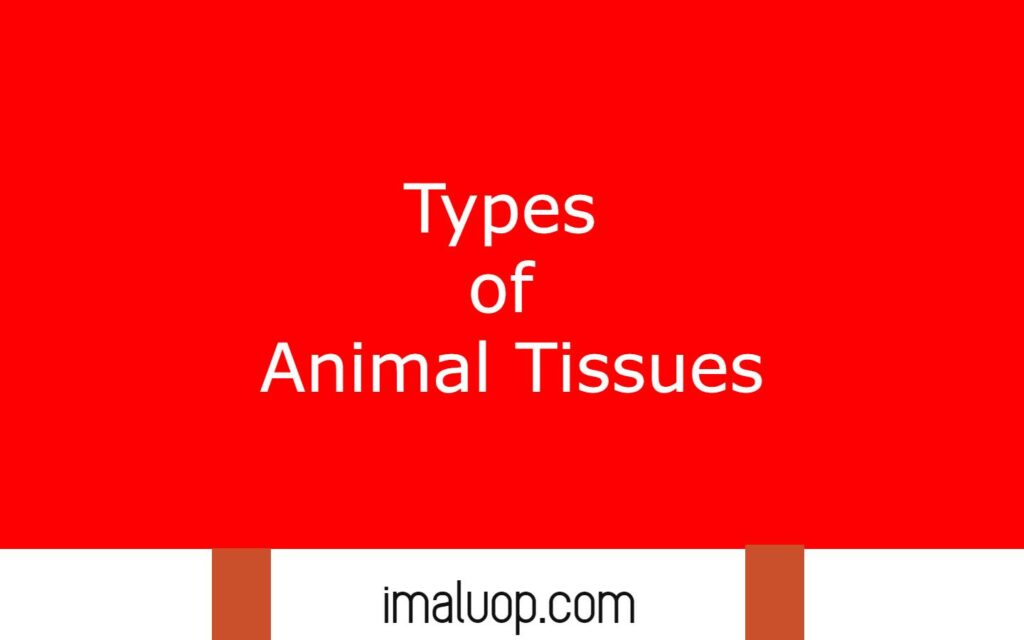Hi, we are going to discuss different types of animal tissues and their structure with their functions in the animal body. In higher animals cells are arranged into different tissues which perform specific functions because the cells in a tissue are specialised for specific functions through the process of differentiation.
As different tissues have different types of function they show differences in their structure as well as origin. For example blood is a tissue in which its constituent blood cells perform the circulation throughout the animal body and they show similarities in their structure and origin.
Table of Contents
Different Types of Animal Tissues:
In advanced animals there are several tissues for different functions like connective tissue, epithelial tissue, muscular tissue and nervous tissue and we will discuss each type of tissue in animals below one by one.
Epithelial Tissue:
It is a type of animal tissue which makes the outer and inner protective covering of a specific organ in the animal body which form first during embryonic development of the animal.
They can develop from any germ layer among the three germ layer ectoderm, mesoderm and endoderm depending upon the organ of the animal. If we think about their origin in evolutionary biology then epithelial tissues are first evolving animal tissue.
Characteristics of Epithelial Tissue:
- They may present in a single layer or multiple layers depending upon how much protection is required so they present in different layers in different organs.
- Plasma membranes of epithelial tissue for those cases where the cells perform to move any particles or structure have cilia as seen in the inner lining of the fallopian tube.
- Epithelial cells have microvilli which is an outer extension of epithelial cells to increase the functional area as seen in the epithelial cells of Intestine which takes part in absorption of food after digestion.
- As they face different challenges during protecting different organs from outside or inside they have high regeneration power to compensate their damage.
- The cells of epithelial tissues connected together end to end with the help of desmosomes, tight junction, zonula adherens, gap junction to make a tough protective covering to protect the organ from externally and internally.
Different Types of Epithelial Tissues and Their Functions:
Epithelial tissue also show variety in their structure and function like glandular epithelial tissue secrete different chemicals, sensory epithelium receive different types of sensory stimulation, absorptive epithelium tissue absorb different materials, pigmented epithelial process pigment like as in the case of retina.
Connective Tissue:
Connective tissue makes connections among different tissues or supports different tissues and they develop from the mesodermal germ layer and we will discuss others characteristics of connective tissue.
Characteristics of Connective Tissue
- Connective tissues have three major types of elements – intercellular matrix which is formed by mucopolysaccharides, different types of connective tissue cells like mast cells, plasma cells, adipocytes, fibroblasts and another constituent is connective tissue fibres like collage fibres, elastic fibres and reticular fibres.
- They are known as connective tissue because they attach different organs and tissues together and make connections between different organs.
- They store fat in the form of adipose tissue and they repair various tissues by different connective tissue like collagen fibres.
Function of Different Types Connective Tissue:
Different types of connective tissue perform different functions in our body – connective tissue properly supports different organs and tissues, vascular connective tissue like blood performs transport in our body, skeletal tissue supports different body parts.
Muscular Tissue:
Muscular tissue performs different major functions in our body like locomotion, different types of movement in digestion and maintains the heart rhythm and many more functions.
Characteristics of Muscular Tissue:
- Muscular tissue helps in movement of our different body structure specially skeletal muscle or voluntary muscle take part in movement and locomotion.
- Smooth muscle takes part in various involuntary functions in our body like peristalsis movement in digestion process and during parturition.
- Cardiac muscle is responsible for maintaining our heart rhythm without any halts because of its specific mechanism of work.

Nervous Tissue:
It is a major tissue for coordination among different body parts and collects external stimuli through different sensory receptors. Nervous tissue originates from ectoderm and helps in transmission of nervous impulse throughout the body to coordinate among different body parts.
Reference: Types of Animal Tissues
Read More: Classification of Animal Kingdom
Hi Everyone!!! Welcome to Imaluop. Imaluop always try to learn some new and he want to share to other people. Here we will try to learn various topics on Science, specially on Biological Sciences.
